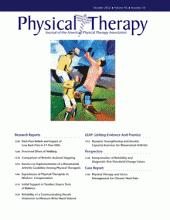Abstract
Background Traditional volumetry based on Archimedes' principle is the gold standard for the measurement of limb volume, but the routine use of this technique is discouraged because of several disadvantages.
Objective The purpose of this study was to evaluate intraobserver and interobserver reliability of direct measurements of wrist-hand volume using a new communicating vessels volumeter based on Pascal's law.
Design A reliability study was conducted.
Methods To evaluate the reliability of the communicating vessels volumeter in generating measurements, 30 hands of 15 participants (9 women, 6 men) were measured 3 times each by 3 observers, totaling 270 volumetric results.
Results Measurement time was short (X̄ =3 minutes 42 seconds). The intraclass correlation coefficient (ICC) was .9977 for observer 1 and .9976 for observers 2 and 3. The interobserver ICC was .9998. The standard error of measurement was about 3 mL for all observers; the interobserver result was 1 mL. The interrater coefficient of variance (CV) was 1.15% for the series of 9 measurements collected for each segment; the intrarater CV was 1.20%.
Limitations No swollen hands were measured, and measurements were not compared with the gold standard technique. Thus, accuracy of the new volumeter was not determined in this study.
Conclusion A new device has been developed for plethysmography of the extremities, and the results of its use to measure the volume of the wrist-hand segment were reliable in both intraobserver and interobserver analyses.
Footnotes
All authors provided concept/idea/research design. Dr de Carvalho provided writing, data collection and analysis, and study participants. Dr Miranda provided project management and fund procurement. Dr Perez and Dr Miranda provided facilities/equipment, institutional liaisons, and consultation (including review of manuscript before submission).
The authors thank Cristiano Campozana de Queiroz, engineer, and Wilson Adriani Filho, engineering technician, for their invaluable technical contributions to the construction of this device, and Dr Alexandre Galvão Patriota, statistician, for the analyses and mathematical models that he prepared for the assessment of the study results.
The Fundação de Amparo à Pesquisa do Estado de São Paulo (FAPESP) awarded for the performance of this study under grant number 05/55240–0 and Núcleo de Proteção Intelectual (NUPI), Paulista School of Medicine, Federal University of São Paulo (UNIFESP), funded the preparation of the patent request for the Communicating Vessels Volumeter, filed under number PI 0502899-0.
- Received May 24, 2011.
- Accepted May 29, 2012.












